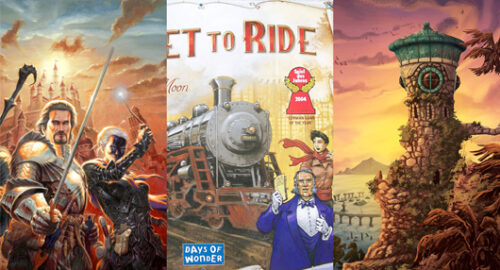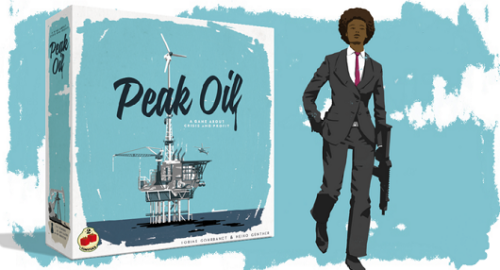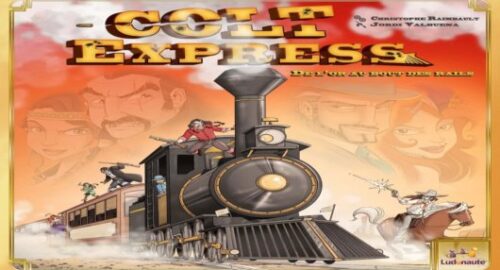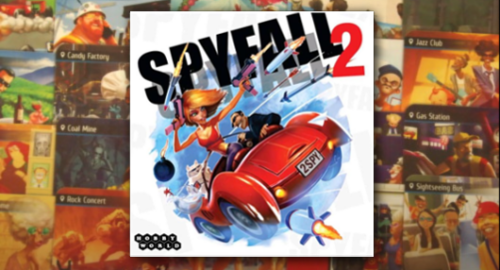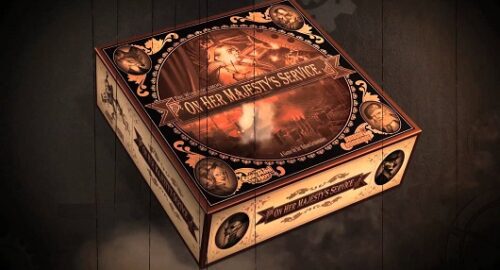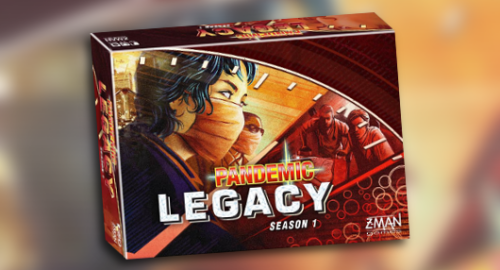Introducing new people to the tabletop hobby can be a tricky business. There are a vast amount of great, albeit complicated games that could easily scare away new players. Luckily there is a host of games ideal for this task, the so-called gateway games. Games like Settlers of Catan or Carcassonne are often used as examples of games that are perfect for newcomers. New York 1901, a new game from Chérnier La Salle bears a striking resemblance to the classic gateway game Ticket to Ride. It has simple rules and beautiful artwork. Is New York 1901 a great board game for newcomers? More importantly, is it any fun?un?
• Designer: Chénier La Salle
• Publisher: Blue Orange Games
• Number of Players: 2-4
• Playing Time: 30-60 minutes

I mentioned above that New York 1901 has a lot in common with 2004 hit Ticket to Ride which requires some clarification. For the uninitiated Ticket to Ride sees each player building their train network across a brightly coloured map of America (or elsewhere depending on the version you’re playing). You do this by drafting and collecting matching coloured cards from a joint supply and using these to fill up various routes gaining points in the process. New York 1901 sees players building a network of skyscrapers across a brightly coloured map of New York City. You do this by collecting matching coloured cards from the joint supply and… I think you get the idea.

Fortunately, of course, there’s enough new in New York 1901 to separate it from Ticket to Ride – this is not merely just a clone or reskin of the classic game. New York 1901 takes the basic mechanics of set collection and hand managements and combines them with an entertaining, Tetris-like, tile placement game. The board in New York 1901 is not just separated into many coloured districts but also into distinct plots of land. These come in two forms; the majority are simple two square plots and the rest as the significantly rarer three square plots. Consequently, the cards you collect on your turn are separated into both colour and plot size. The skyscrapers you place on the board throughout the game come in a huge variety of shapes and sizes and will require different combinations of plot cards to get them on the board.

Perhaps the games largest departure from Ticket to Ride, however, is the inclusion of a limited hand mechanic. One of Ticket to Ride’s biggest flaws, which becomes apparent after a few games, is that you’re allowed to hoard an unlimited number of cards. Simply taking cards every turn rather than focusing on building smaller routes is by far a better strategy and in New York 1901 you pretty much can’t do this. On your turn when you claim a plot card from the four available you place one of little worker figures on the plot of land on the board you’re acquiring. So if you take that three square green card, you don’t add it to you hand per se but instead, place a worker on any one of the currently available three square green plots on the board. The important point here is that you only have four employees and can only keep acquiring plots of land as long as you have a free worker available. Once you’ve purchased a plot of land, you have the option of immediately playing a building tile straightaway or accumulating some adjacent plots over multiple turns to build your bigger more valuable skyscrapers.

Unsurprisingly the board fast becomes cluttered, with skyscrapers and workers as players start acquiring land all over NYC. This brings us to the second thing you can do on your turn – demolish and rebuild. Each player has three types of skyscrapers, from the lowest scoring bronze to the highest scoring gold (with sSilver in the middle) You can build the higher value skyscrapers using the method mentioned above, slowly acquiring plot cards but the easier way is to replace your older redundant buildings. Herein lies the games main puzzle, working out which buildings to demolish and when, and how to combine this with your workers to get the biggest and best skyscrapers on the board.
It also separates the game into some clear phases. You can’t build silver or gold buildings whatsoever until you accrue a set number of initial points so the early game sees each player racing to build up that early score. Demolished buildings can only ever be replaced by buildings of a higher rank which give a degree of permanence to each of your decisions. You can never go backwards, and any bronze or silver buildings you demolish are gone for good. Once gold buildings hit the board, then they stay there until the end of the game which requires some important decisions about where, and when you place them. This is further compounded by the host of end game scoring options that are present in each game.

The buildings themselves are worth some points when placed but a significant amount of your endgame score will come from a series of cards that are randomised at the games start. The first of these are the streets of New York cards. There are five named roads on the New York 1901 board that reflect important roads in the city, including Wall Street and Broadway. You may have heard of them I think they’re quite famous. At the start of each game three of these roads are selected as random and offer bonus points at the end of the game to the player with the most buildings on that road at the end of the game. The important distinction here is that only the number of buildings matters and not their value. Gold buildings are a hell of a lot bigger than their bronze counterparts which represent an interesting dilemma. Do you fill the board with higher scoring buildings in the short term or fill the important roads with smaller buildings to gain more points in the long term? On top of all this confusion are the bonus cards, one of which is chosen at random and adds another dimension to end game scoring. This could be the Master Architect card which rewards you for building your funky shaped non-square skyscrapers or the Bronze Baron which rewards players for keeping their bronze buildings to end game scoring rather than just replacing them. The rules recommend you play without a bonus card in your first game, but honestly, it’s these cards that separate and focus your game, and I would include them.

There are a few other rule nuances I could discuss. How action cards allow you to do more on your turn for example or how the legendary skyscrapers offer some high-end game points. Overall New York 1901 managers to maintain the feel and tone of Ticket to Ride whilst maintaining its own sense of identity and unique mechanics. However, this doesn’t answer the important question – is New York 1901 actually any good. Well first off, it is an utterly beautiful game. It’s colourful, it’s vibrant and the artwork by Vincent Dutrait is some of the best in all of board gaming. The game itself is definitely fun and I’ve enjoyed the puzzle it presents but, when push comes to shove, I still think I’d actually prefer to play Ticket to Ride. One of the most exciting things about Ticket to Ride is all the hidden information. Each player has a hand of routes worth a number of points depending on how long and complicated that route is. Complete the route and you get those points at the end of the game but, fail to do so and you’ll lose that amount of points. In effect this could be seen as analogous to the Streets of New York and Bonus Challenge cards in New York 1901 giving you some direction and focus beyond just collecting cards and building train tracks. However, the fact this is completely hidden information just makes everything more tense. In New York 1901 everything is open. Where you place your workers, the streets that are worth the end game points it’s all information that each player always has access to. This isn’t necessarily a bad thing but, in my opinion, it removes the game of any real tension. Sure a player can block you by placing a worker next to yours but it is no where near as tense as say, building a train route from Miami to Seattle and hoping no one notices.

If I were introducing players to the hobby I find it unlikely I would use New York 1901 to do so. Instead, I’d play a game of Splendor, Colt Express or Codenames to show them how much fun this hobby can be. Moreover, I’m not particularly sure whether this game would be an excellent way to introduce someone to the hobby at all. It is certainly more complicated than Ticket to Ride and some of the rules nuances do take a while to get used to. This is exemplified by a rather frustrating rule book that omits some play examples. There’s a guide available online which helps iron out these problems and apparently it will be included in later editions of the game but for now, it’s not and that is a bit annoying. Overall though the game isn’t that complicated… In fact, I don’t really know who this game is aimed. Medium weight games are a very useful thing to have but I feel, for me at least, this game simply falls into a rather dull middle ground of too complicated and not complicated enough.
I’ve reviewed a fair few games for BigRedBarrel now. Somewhere absolutely fantastic whilst others were…less so. New York 1901 falls into neither of those categories it is simply an okay, mediocre game. It is definitely pretty and deep down there is an interesting puzzle combining set collection and tile management. Overall though it lacks the punch or strategy required to really make a game. I’m sure I will play it again at some point but will I crave to play it and mull over strategies long afterwards? I doubt it.

